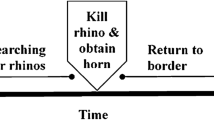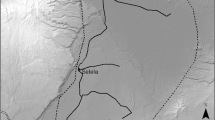Abstract
Increasing levels of visitor use and consequent resource damage have necessitated that backcountry use restrictions be established in the Mineral King area of Sequoia National Park, California. In this paper we review the steps taken in developing a trailhead quota system. The availability of acceptable campsites, based on a detailed inventory of site distribution and impact, was used to quantitatively derive use capacities for each camp area. Wilderness permit data on visitor dispersal patterns from the major trailheads, including length of stay at each camp area, were then used to translate the area capacities into daily trailhead quotas that would assure that these capacities were not surpassed. The general approach is applicable to any backcountry area, although large complex areas may require the use of available computer simulation models.
Similar content being viewed by others
Literature cited
Bratton, S. P., M. G. Hickler, and J. H. Graves. 1978. Visitor impact on backcountry campsites in the Great Smoky Mountains.Environ. Manage. 2:431–442.
Cole, D. N. 1978. Estimating the susceptability of wildland vegetation to trailside alteration.J. Appl. Ecol. 15:281–286.
Cole, D. N. 1981. Managing ecological impacts at wilderness campsites: an evaluation of techniques.J. Forestry 79(2):86–89.
Dale, D., and T. Weaver. 1974. Trampling effects on vegetation of the trail corridors of north Rocky Mountain forests.J. Appl. Ecol. 11:767–772.
DeBenedetti, S. H., and D. J. Parsons. 1979. Mountain meadow management and research in Sequoia and Kings Canyon National Parks: a review and update. Pages 1305–1311in R. Linn, ed., Proceedings First Conference on Scientific Research in the National Parks. US.D.I. National Park Service Trans. and Proc. Series No. 5.
Fazio, J. R., and D. L. Gilbert. 1974. Mandatory wilderness permits: some indications of success.J. Forestry 72:753–756.
Frissell, S. S. 1978. Judging recreation impacts on wilderness campsites.J. Forestry 76:481–483.
Hendee, J. C., G. H. Stankey, and R. C. Lucas. 1978. Wilderness Management. U.S.D.A. Forest Service Misc. Publ. No. 1365.
Kraushaar, J. M., D. Parsons, and T. Stohlgren. 1980. Wilderness permit accuracy—the nature and extent of differences between actual and planned backcountry use. Unpublished manuscript.
Parsons, D. J. 1979. The recovery of Bullfrog Lake.Fremontia 7(2):9–13.
Parsons, D. J., and S. H. DeBenedetti. 1979. Wilderness protection in the high Sierra: effect of a 15-year closure. Pages 1313–1317in R. Linn, ed., Proceedings First Conference on Scientific Research in the National Parks. U.S.D.I. National Park Service Trans. and Proc. Series No. 5.
Parsons, D. J., and S. A. MacLeod. 1980. Measuring impacts of dispersed visitor use on wilderness lands.Parks 5(3):8–12.
Rundel, P. W., D. J. Parsons, and D. T. Gordon. 1977. Montane and subalpine vegetation of the Sierra Nevada and Cascade ranges. Pages 559–599in M. G. Barbour and Major, eds., Terrestrial Vegetation of California. J. Wiley & Sons, NY.
Shechter, M., and R. C. Lucas. 1978. Simulation of recreational use for park and wilderness management. John Hopkins Univ. Press, Baltimore, MD. 220 pp.
Stankey, G. H., and J. Baden. 1977. Rationing wilderness use: methods, problems and guidelines. U.S.D.A. Forest Service Research Paper INT-192. 20 pp.
United States Forest Service. 1976. Mineral King final environmental statement. Sequoia National Forest, Porterville, California. 285 pp. and appendices.
van Wagtendonk, J. W., and J. M. Benedict. 1980. Wilderness permit compliance and validity.J. Forestry 78(7):399–401.
Author information
Authors and Affiliations
Rights and permissions
About this article
Cite this article
Parsons, D.J., Stohlgren, T.J. & Fodor, P.A. Establishing backcountry use quotas: An example from Mineral King, California. Environmental Management 5, 335–340 (1981). https://doi.org/10.1007/BF01867347
Issue Date:
DOI: https://doi.org/10.1007/BF01867347




